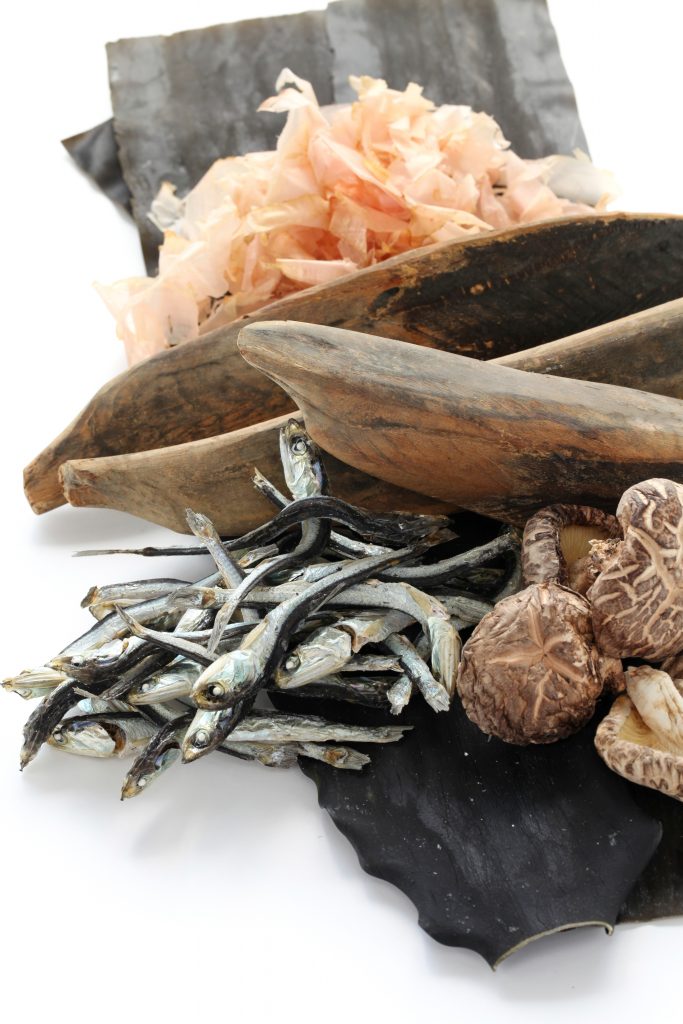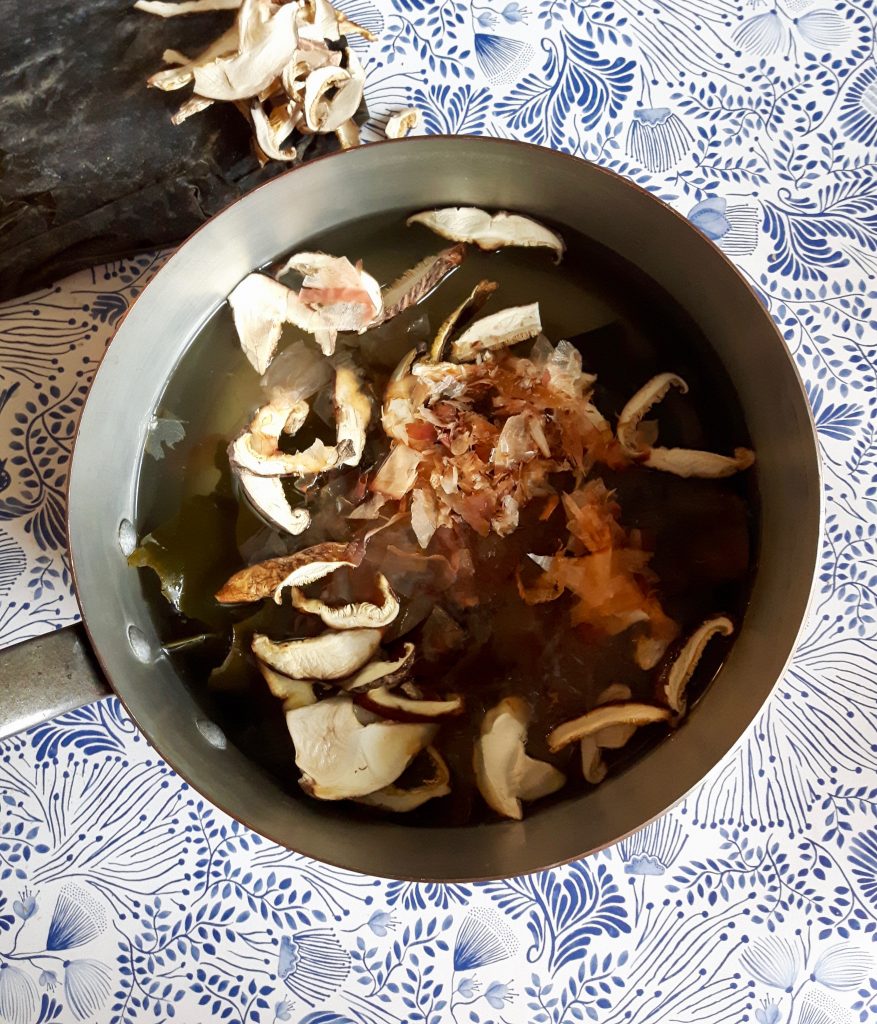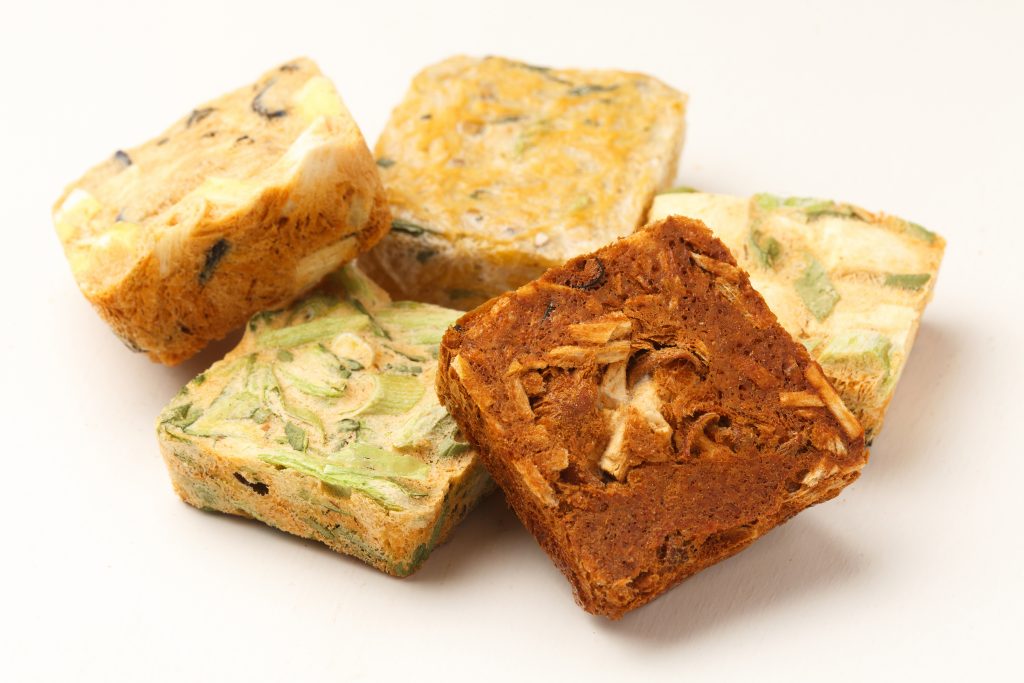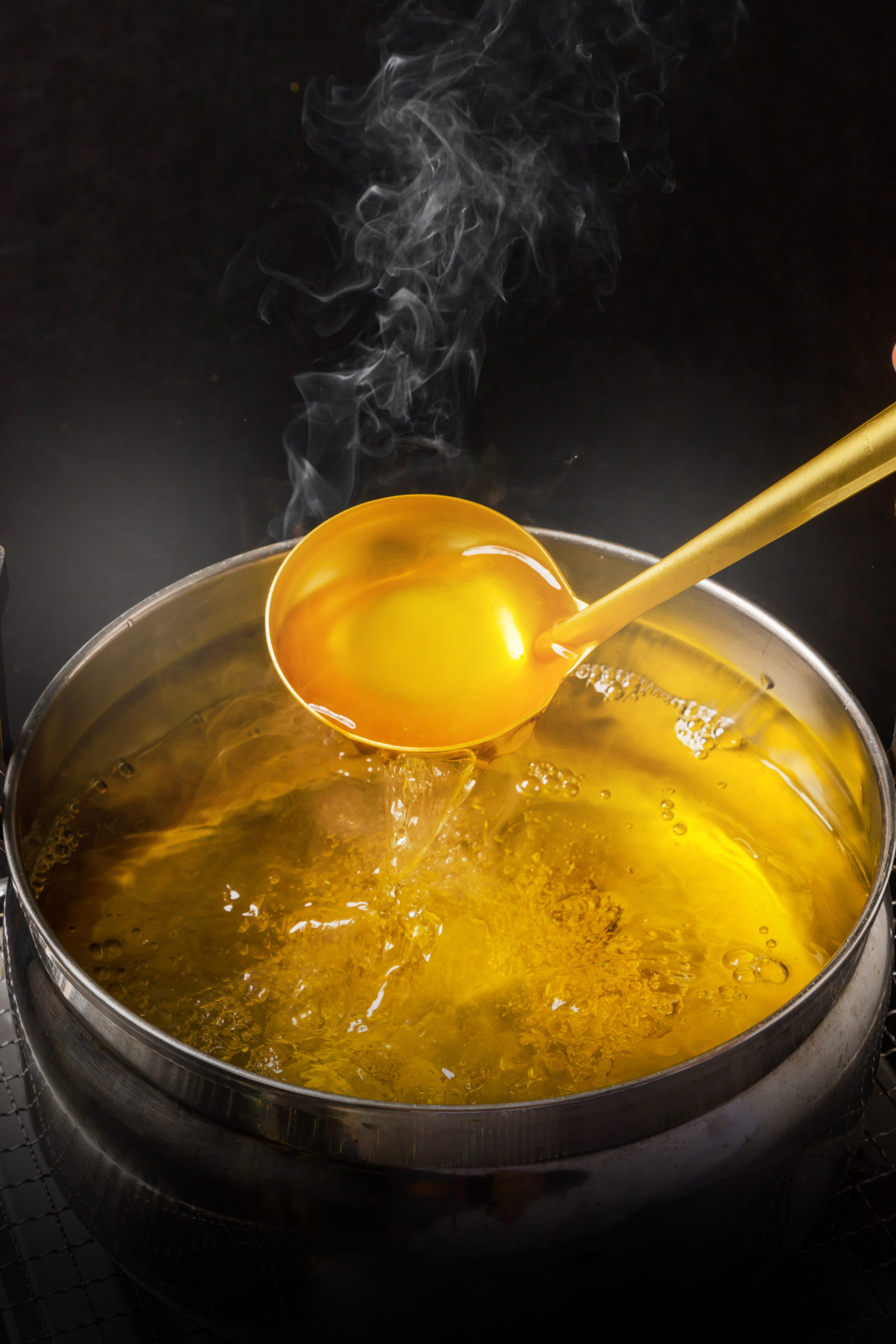Japan loves its traditional cuisine, whether it be adapted, borrowed or indigenous. Shun is an important Japanese concept, it means cooking with seasonal ingredients so that the product provides the most amount of fresh flavor. This concept of Shun influences elements of taste and cooking techniques so that flavor can be preserved and enhanced through each dish (Seligman, L., 1994).
Dashi is one of the most important components of Japanese cuisine, a fundamental ingredient in various dishes, soups, and sauces. What exactly is Dashi?
Dashi – Japanese Stock
Historically soup has been an incredibly important part of traditional Japanese cuisine, oftentimes (and to this day) served at least once a day if not more. There are distinct preparations and names for soup depending on when it is served and with what. There is sumashi-jiru, which is a clear broth often colored with soy sauce and miso-shiro, broth with fermented miso paste added to it. There are many more varieties of soup, though it is likely that miso is the one that you are most familiar with. It is a starter to your plate of sushi, as well as the wonderful broth that holds your ramen together. At the beginning of all these soups (as well as other dishes and sauces) is Dashi (Ishige, N., 2014).
Dashi is a Japanese stock, made most commonly with konbu a variety of kelp that grows around Japan. However, depending on the prefecture in Japan the ingredients and preparation of the stock may vary drastically. The fundamentals of it do not change. Dashi is the result of slow flavor extraction. It uses low heat and time to extract the nourishment and flavor from the few ingredients used to make a stock that holds a lot of umami potential.
Dashi apart from being an essential part of Japanese cuisine is also the essence of Umami. Umami is the fifth taste which is based on a combination of the amino acid glutamic acid and nucleotides inosinate and guanylate. This combination is found constantly in dashi. Kombu combined with either katsuobushi or shiitake will lend an amazing umami flavor as all three substances are present in the stock. The important thing to remember about dashi stock, though the flavor may be mild on its own when combined – for example – with miso paste there is an explosion of flavor with is complex and outstanding.
It is for this reason, its mild umami-ness, that dashi can be incorporated into so many different dishes, soups, and sauces. It brings up the flavor of ramen, miso soup, etc. It is also used at all levels of cuisine, such as ceremonial kaiseki or a sumo wrestler stew chankonabe (O’Connor, K., 2017).

Shojin Ryori
Shojin Ryori which means the pursuit of a perfect state of mind is a traditional Japanese Vegetarian Cusine or “Temple Food” that was developed by Zen Buddhists in the 12 century. It became frowned on to consume animal flesh in all its forms as a result in the making of dashi katsuobushi was omitted and replaced with dried shiitake mushrooms so as to enhance the umami flavor of the broth (Riccardi, V.A, 2003., & ed., Edelstein, S., 2011).
Dashi Stock
Five dashi stocks are very common in Japanese cuisine, appearing throughout the country being used in homes and restaurants alike. When you begin to make most dashi you begin with konbu or kelp, heck, even dulse can be used to make dashi. You leave the seaweed in soft, room temperature of cool water for between 30 minutes to overnight (I like to leave it overnight). Once the konbu has soaked the steps change depending on the kind of dashi you wish to make. An important thing to note, no matter the type of dashi that you are making is that it does not at any point boil! After the konbu has soaked and it is ready for the next part of your dashi making process it can be heated slightly but never to the point of boiling (O’Connor, K., 2017).
Konbu Dashi
Place a piece of konbu, approximately 10g of dried konbu per 1Liter of room temperature water, if you are using more water increase it from there. It is also preferable to use soft water but filtered or tap water, if it is drinkable, is fine as well (just let the chlorine evaporate). You can let the water with the konbu rest on the counter for 30 minutes or place the solution into the fridge and let it sit overnight (this is preferable) (Mouritsen, O.G., et al., 2012).
Once you are ready to begin making the dashi stock, empty the water and the konbu into a pot and heat the water on medium. Before the water comes to a boil remove the konbu (or it will get slimy and make the broth too viscus) and turn off the heat. The dashi is done! However, it is also at this step that other ingredients such as katsuobushi, shiitake, etc can be added to enhance the umami of the broth.
Ichiban-Dashi or Awasedashi
Known as the first dashi, this base is often used in sumashi-jiru, using Konbu and katsuobushi for the stock. Let the konbu soak in room temperature water for between 30 minutes to overnight in the refrigerator. In a pot begin to heat the water with the konbu in it. Just before it begins to boil remove the konbu. At this point, the katsuobushi can be added. Let it come to boil, turn off the heat and let it sit for a few minutes (around 5) (Fujita, C., 2009).
Niban-Dashi
The used bonito flakes and konbu from Ichiban-dashi are reused to make niban-dashi, known as the second dashi, as it uses the ingredients a second time. This dashi will require less water than the first, as the flavor of the stock will be very soft and too much water will dilute it further. This type of dashi serves as a stock for richly flavored dishes, such as miso or ramen. After this dashi is made the bonito and konbu can no longer be used, you can always compost them though (Ishige, N., 2014).
Niboshi Dashi
This dashi only requires anchovies (though you can also use small sardines). This type of dashi stock will require about 30g of anchovies for 1 Litre or clean water. You can remove the heads and such, but I don’t bother and throw the whole things in. The Liter of water can also be a Liter of konbu dashi.
Let the water or konbu dashi with the anchovies come to a gentle boil. Turn off the heat and let the stock set for 4-5 minutes. Strain and you have made niboshi dashi (Umami Info, 2017).
Shojin Dashi
This is another vegan/vegetarian dashi broth. It plays off the konbu dashi but provides more umami flavor with the incorporation of dried shiitake mushrooms. You can use fresh mushrooms, however, the drying process of the shiitakes gives them a more robust, savory flavor.
Begin by making konbu dashi, as soon as the konbu has been removed (just before the stock boils) add in the dried shiitake mushrooms. These mushrooms should be let to rehydrate in 1 Liter of water (add about 150g of shiitake mushrooms) for at least half a day before they are thrown into the pot (with the water they soaked in). Let the shiitakes cook in the broth for a few minutes and turn off the heat. Strain the mushrooms out. The result will be a very flavourful and savory richly colored broth.
Other Types of Dashi
Hokkaido’s Ma-Kombu
This dashi is highly prized in Hokkaido (as well as across Japan), it makes clear dashi with the use of fermented kombu (O’Connor, K., 2017). Ma Kombu has the highest levels of glutamate with about 3.2 g of glutamic acid per 100g serving and its drying end fermentation process further enhances its flavor profile (Mouritsen, O.G., et al., 2012).
Agodashi
This dashi is from the seaside town of Hirado which is west of Kyushu Island. Ago is a young flying fish that is harvested once a year in September. They are either salt simmered or charcoal-grilled before being dried in the sun. At this point, they are ready to be used in the making of dashi. The flying fish provides this dashi with a very distinct flavor (Hachisu, N.S., 2015). Nordic Dashi made with dulse which is a locally grown seaweed that has a high glutamic acid content (though not quite as high as konbu) providing the dulse broth with an umami flavor.

Dashi Ingredients
Anchovies
These wonderful little fish thrive in warm water and are very common to the Mediterranean, the Black Sea and throughout Asian Waters. They are often used to make dashi fresh or dried. They are a high source of omega 3 fatty acids, they are a good source of calcium and vitamin K. Anchovies are also very heart protective.
Katsuobushi
A rich source of omega 3 fatty acids and zinc. In 1674 katsuobushi was simply smoke-dried which was a common method at the time. In 1770 the method of growing mold on the smoke-dried fish fillet was incorporated. There are several stories as to how it came that mold was added to the process – the main thing to note is that it provided a far more in-depth flavor to the dried fish and the dishes that it was used in (Fujita, C., 2009).
This dried and fermented fillet of a Bonito (also referred to as Bonito flakes), a variety of tuna has been a long-time ingredient in the making of dashi. Often made with Skipjack Tuna, a higher-end restaurant in Japan, called Ryotei, often use Tuna bushi instead as it has a deeper flavor and is more highly prized in Japan. Katsuobushi is very tough, thus requiring a special tool to cut it into thin pieces, thicker savings called Arai Kezuri are often used in the making of dashi stock (Hachisu, N.S., 2015).
Konbu
Konbu (or Kombu), algae of the order Laminariales, grows to be upwards of several meters and has a width that ranges from 10-30 cm. It is grown in the Sea of Japan (which lies between China and Japan). Konbu contains a large amount of glutamic acid, which is a non-essential amino acid (the building block to l-glutamine which is made by the body).
After it is harvested it is sundried. The highest quality of konbu, which also provides the best quality of umami is aged in cellars for as little as a year to as long as ten years, with the most common aging period being 2 years. The aging or fermenting process is important as it produces a milder flavor and the umami becomes more pronounced (Mouritsen, O.G., et al., 2012).
Shiitake
Shiitake mushrooms are incredibly healing. They are a great source of copper, pantothenic acid, selenium and vitamin B2, as well as zinc and manganese. A wonderful source of vitamin D, containing approximately 840IU per 100 g. Shiitake mushrooms in the making of dashi are often used as a vegetarian or vegan replacement for katsuobushi or anchovies.

Dashi-no-moto – Instant Dashi
Just as we have bouillon cubes in for replacing chicken or beef stock so does dashi have an instant format. We seem to be spending less and less time in the kitchen, and as a result of people in Japan wanting to keep their miso soup but not work on it, dashi-no-moto was created. Often appearing in granular format sometimes it is also a fine powder.
The first instant dashi and the main ingredient in almost all instant dashi’s today are MSG. What MSG was able to provide was a quick way to give the umami flavor to a dish, such as miso soup without it having to take time to prepare. When Ajinomoto began marketing MSG in the early 1900’s they focused on housewives in Japan, who wanted to bring innovation and science into the kitchen. This new identity of the bourgeois housewife reveled at the use of MSG, and with its emergence, they experimented with taste and out of the Japanese kitchens came teriyaki and tonkatsu. The “pure white”ness of MSG was attractive to women, as hygiene was imperative (Sand, J., 2005). However, the love of MSG faded in Japan as it did in most countries in the 1990s. Many Japanese (and Chinese) chefs decided to leave the MSG and focus on traditional practices and local ingredients to make flavorful dishes that they could be proud of. Many ramen chefs will tell you to taste their broth first as it requires the most amount of work some taking 10+ hours to complete. MSG broths would not take that time.
You can find dashi-no-moto that does not include MSG and instead incorporates wholefoods in powdered form for a quick dashi base for breakfast miso. Make sure to read the ingredients beforehand. Another prominent ingredient in many of the instant dashi’s on the market is sugar, commonly labeled as simply ‘sugar’ but also as; glucose, dextrin, lactose (milk sugar).
References
ed. Edelstein, S. (2003). Food Cusine, and Cultural Competency for Culinary, Hospitality and Nutrition Professionals. Jones and Barlett Publishers: Boston.
Fujita, C. (2009). Dried Bonito. The Tokyo Foundation for Policy Research.
Ishige, N. (2014). History of Japanese Food. Routledge: New York.
Hachisu, N.S. (2015). Preserving the Japanese Way. Andrew McMeel Publishing.
Mouritsen, O.G., Williams, L., Bjerregaard, R., Duelund, L. (2012). Seaweeds for Umami Flavour in New Nordic Cusine. Flavour Journal. Volume 1, Issue4, pages 1-12.
Riccardi, V.A. (2003). Untangling My Chopsticks: A Culinary Sojourn in Kyoto. Broadway Books: New York.
O’Connor, K. (2017). Seaweed. A Global History. Reaktion Books: London.
Sand, J. (2005). A Short History of MSG. Good science/bad science/taste culture. Gastronomica: The Journal of food and culture. Volume 5, Number 4, page 38-49.
Seligman, L. (1994). The History of Japanese Cusine. Japan Quarterly. Volume 41. Issue 2.
Tsuji, S. (2006). Japanese Cooking. A Simple Art. Kodansha International: Tokyo.
Umami Information Center. (2017). The Story of Dashi.
Amanda Filipowicz is a certified nutritional practitioner (CNP) with a bachelor in environmental studies (BES) from York University. She also has certification in clinical detoxification, prenatal and postnatal care as well as nutrition for mental health. She has been working as a nutritionist since 2013 and is a lifelong proponent of eating healthy.

